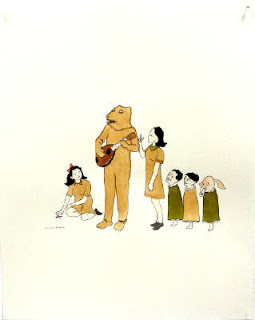For an example, we talked briefly about Peter Doig. His paintings are imaginary environments but a figure tends to anchor the landscape, making it a breathable space.
 |
| Peter Doig |
Marcel Dzama as a counterpoint to Doig.
 |
| Marcel Dzama |
We discussed how the photographic reference should be the starting point of the image. Marlene Dumas uses images that are unflattering or voyeuristic. Because they form a fragmented narrative, the meaning of the image is left up to the viewer.
 |
| Marlene Dumas |
We then talked about Lucien Freud and how his sculpted marks begin to create a "fleshiness" of paint. The constant laying down marks, scraping them off, and then placing them back on, lend the painting a certitude: this is wear the marks should go . . . here's the evidence.
 |
| Lucien Freud |
Jenny Saville's work is similar in that the paint is used richly and "fleshily" except that the fragmented narrative of the image is heightened.
 |
| Jenny Saville |
Luc Tuymans work is interesting in that its a series of negations . . . like there was an elaborate scene painted, and then pared back. This gives his work an emptiness that is rather unsettling.
 |
| Luc Tuymans |
I want to approach this assignment building on the idea of making a painting with the figure as an excuse for the painting to happen. This one might be hard for me just because I have my own hang-ups about the figure. Hopefully, I can leave them at the door and make an interesting painting.
No comments:
Post a Comment